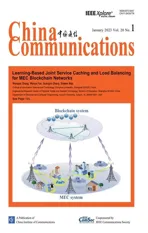OTFS Modulation and PAPR Reduction for IoT-Railways
2023-02-02HuichaoShangRuifengChenHaoxiangZhangGuoyuMaRuisiHeBoAiZhangduiZhong
Huichao Shang ,Ruifeng Chen ,Haoxiang Zhang ,Guoyu Ma ,Ruisi He ,Bo Ai ,Zhangdui Zhong
1 State Key Laboratory of Rail Traffic Control and Safety,Beijing Jiaotong University,Beijing 100044,China
2 Institute of Computing Technologies,China Academy of Railway Sciences Co.,Ltd.,Beijing 100081,China
3 China Academy of Industrial Internet,Ministry of Industry and Information Technology,Beijing 100804,China
Abstract: The internet of things (IoT) has been widely considered to be integrated with high-speed railways to improve safety and service.It is important to achieve reliable communication in IoT for railways (IoT-R) under high mobility scenarios and strict energy constraints.Orthogonal time frequency space (OTFS) modulation is a two-dimensional modulation technique that has the potential to overcome the challenges in high Doppler environments.In addition,OTFS can have lower peak-to-average power ratio(PAPR)compared to orthogonal frequency division multiplexing,which is especially important for the application of IoT-R.Therefore,OTFS modulation for IoT-R is investigated in this paper.In order to decrease PAPR of OTFS and promote the application of OTFS modulation in IoT-R,the peak windowing technique is used in this paper.This technique can reduce the PAPR of OTFS by reducing the peak power and does not require multiple iterations.The impacts of different window functions,window sizes and clipping levels on PAPR and bit error rate of OTFS are simulated and discussed.The simulation results show that the peak windowing technique can efficiently reduce the PAPR of OTFS for IoT-R.
Keywords: internet of things for railways (IoT-R);orthogonal time frequency space (OTFS);peak-toaverage power ratio(PAPR);peak windowing
I.INTRODUCTION
With the rapid development of the internet of things(IoT),IoT technology has gradually attracted attention of railway industries and research institutes all over the world.IoT technology can realize intelligent perception,identification and management of objects and processes through a variety of sensors,radio frequency identification components,global positioning system and other equipment and technologies[1].In addition,with the fast development of high-speed railway (HSR),the requirements for informatization in HSR continue to increase,and IoT has become an inevitable choice to improve the digital and intelligent level of railway infrastructure.The advanced information technology is indispensable to the safety and quality of service of HSR.Driven by advanced information technologies,HSR has entered the era of intelligent HSR,in which the IoT for railways (IoT-R)plays an important role[2-6].
The IoT-R technology aims to realize environmental perception for intelligent railways.The environmental perception of railways includes natural disaster monitoring,intrusion warning and railway infrastructure monitoring [7].By deploying a large number of terminal sensing devices,the information of surrounding environment can be transmitted to the train and data center in a timely manner,enabling personnel to make timely and correct decisions.The environmental perception of railway has the characteristics of wide monitoring range,large quantity,low power consumption and low data rate,which are supported with IoT technology.Therefore,IoT-R can provide strong support for the realization of intelligent monitoring,operation and decision-making in railways.
One of the core issues of IoT-R is how to achieve reliable communication between mass terminals and trains under high mobility scenarios and strict energy constraints,which is the basis for realizing realtime and comprehensive environmental perception of railways.In the traditional IoT scenarios,static and low-speed motion states are often considered,while the significant differences between IoT-R and IoT lie in its high-speed mobility and complex railway environments.As shown in [7],a base station (BS) on a high-speed train communicates with multiple terminals around it.Such communication architecture needs to support the application with high mobility.In the past few years,orthogonal frequency division multiplexing(OFDM)is widely used in long term evolution and narrowband IoT systems due to its high spectrum efficiency and robustness to multipath fading[8-10].However,in high mobility scenarios of IoT-R,carrier frequency offset created by Doppler shift destroys the orthogonality of subcarriers and generates inter carrier interference which significantly reduce its performance[11].
Recently,a novel modulation scheme for wireless communication under high mobility named orthogonal time frequency space (OTFS) modulation is proposed to support reliable communication[12].OTFS can be accomplished by adding pre-processing and post-processing modules to traditional multi-carrier modulation schemes[13].The information symbols of OTFS are placed in delay-Doppler(DD) domain.A rapidly time-varying multipath channel will exhibit slow variation in DD domain.In other words,compared with the time-frequency(TF)representation,the DD representation of the multipath channel makes it have longer time invariance.In addition,wireless channel in DD domain exhibits some beneficial features including sparsity,compactness,separability and stability[14-16].This is very beneficial for reducing the channel estimation overhead in a rapidly timevarying channel [17-19].Therefore,OTFS modulation can be well integrated with IoT-R.
The IoT-R terminal devices generally transmit small packets and operate under strict transmit power constraint to extend their battery life,which is important for railway applications to reduce cost.It is needed to maximize the link budget and minimize the number of retransmissions (energy per bit of information) under transmit power constraint[20].To maximize link budget under these constraints,it is necessary to reduce the peak-to-average power ratio (PAPR) of the transmitted signal.To minimize the number of retransmissions,time and frequency diversity gains should be extracted.OTFS modulation can have lower PAPR compared to OFDM and fully extract time and frequency diversity gain.Therefore,OTFS modulation shows its application potential in IoT-R.
The PAPR of OTFS is characterized by a linear increase with the number of Doppler binsNand dose not change with the number of delay binsM(the number of subcarriers in TF domain).The characteristic of the PAPR of traditional multi-carrier waveform,such as OFDM,is that it increases linearly withM[21].For small values ofN,the PAPR of OTFS is lower than that of OFDM.Therefore,OTFS modulation shows its potential in IoT-R.However,asNincreases,the PAPR of OTFS and OFDM are almost the same.It is important to have low PAPR for IoT-R terminal devices because it can extend the battery life of railway terminals and improve energy efficiency of railway system.In order to further decrease the PAPR of OTFS for high values ofN,it is essential to investigate techniques for reducing the PAPR of OTFS.
Currently,the main techniques for reducing the PAPR of OTFS includeµ-law companding technique[22]and iterative clipping and filtering technique[23].As a nonlinear transformation,theµ-law companding technique has been widely used in PAPR reduction.Theµ-law companding technique keeps the peak value of the signal constant while increasing the amplitude of the low signal.Therefore,this process reduces PAPR by keeping the peak power constant and increasing the average power.Although such PAPR reduction technique is simple to implement,it cannot reduce terminal energy consumption,so it is not suitable for the application in IoT-R.On the other hand,iterative clipping and filtering technique is a useful scheme for reducing PAPR.This technique first clips through a preset threshold and then filters through a filter.This process needs to be iterated several times because the filtering will cause the peak value to regenerate.So the complexity of this technique increases with the number of iterations.Low-complexity techniques are more preferred in IoT-R.In addition,iterative clipping and filtering technique is a hard clipping technique,thus causing great damage to the signal.
Considering that the existing techniques of reducing the PAPR of OTFS have some shortcomings in IoT-R as mentioned before,the peak windowing technique for reducing the PAPR of OTFS has been used.The contributions are summarized as follows.
• The suitability of OTFS modulation for IoT-R with high mobility is tested and related simulations are conducted.On the one hand,OTFS modulation has good performance against Doppler shift in high mobility scenarios.On the other hand,OTFS can have lower PAPR compared to OFDM and fully extract time and frequency diversity gain.The simulation results validate its potential in IoT-R.
• OTFS transmitter with peak windowing block is used for reducing PAPR of OTFS.Unlikeµ-law companding technique,peak windowing technique limits high peaks by multiplying them with a weighting function called window function.It can reduce peak power so as to reduce PAPR of OTFS,thus reducing terminal energy consumption.Compared with iterative clipping and filtering technique,peak windowing technique does not require multiple iterations to reduce PAPR of OTFS,thus its complexity is relatively low.In addition,such limit method is a smoother way compared with hard clipping.
• The performance of peak windowing technique to reduce PAPR of OTFS is fully evaluated through numerical simulations.Specifically,the impacts of different window functions,window sizes and clipping levels on the PAPR and bit error rate(BER)of OTFS are simulated.The simulation results show that the peak windowing technique can well reduce PAPR of OTFS with fairly reasonable BER loss.
The rest of this paper is organized as follows.In Section II,OTFS system is introduced.The peak windowing technique is shown in Section III.The simulation results and analysis are presented in Section IV.Finally,Section V presents conclusion.
II.ORTHOGONAL TIME FREQUENCY SPACE MODULATION SYSTEM
This section briefly presents the OTFS modulation system.Specifically,the mathematical description of modulation/demodulation in DD and TF domain is presented.Then,the PAPR of OTFS is shown.
2.1 OTFS Modulation
The OTFS modulation system diagram is shown in Figure 1.At the OTFS transmitter side,the information symbols are firstly mapped to the DD domain.Inverse symplectic finite Fourier transform (ISFFT) is used to convert DD domain symbolsx[k,l]to TF domain symbolsX[n,m].Then,the time domain signals(t) can be obtained by the Heisenberg transform ofX[n,m].At the OTFS receiver side,Wigner transform is firstly used to convert the received time domain signalr(t) to TF domain symbolsY[n,m],and then to DD domain using symplectic finite Fourier transform(SFFT)for symbol demodulation.

Figure 1. OTFS mod/demod.
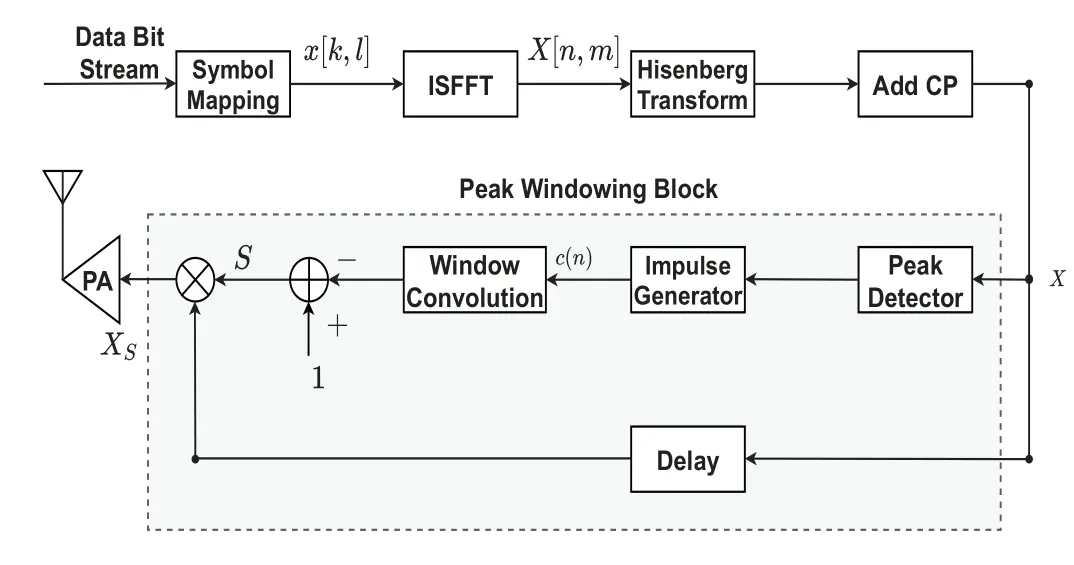
Figure 2. OTFS transmitter with peak windowing block.
The ISFFT in OTFS modulation can be written as[12]

In addition,SFFT at OTFS receiver side can be expressed as

The ISFFT and SFFT mentioned above can be regarded asM-point FFTs along each Doppler andNpoint IFFTs along each delay,and their inverse,respectively[24].
The Heisenberg transform converts the symbols in TF domain to a continuous time domain signal as[25]

The Wigner transform can be written as

Thegtx(t) andgrx(t) denote transmit and receive pluses,respectively.The ideal pulses that satisfy the bi-orthogonal property can eliminate symbol interference.Ifgtx(t) andgrx(t) are rectangular pulses,(3)and(4)simplify to a collection ofM-point IFFTs and FFTs along each time,respectively.Hence forN=1,(3) and (4) are equivalent to OFDM modulation and demodulation,respectively[24].
2.2 PAPR of OTFS
From the OTFS modulation process,the discrete time representation of(3)can be obtained by Nyquist sampling,given by

According to the definition of PAPR,the PAPR of OTFS can be defined as
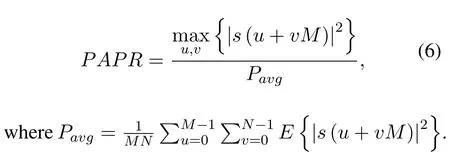
Substituting(5)into the numerator and denominator of (6),the maximum PAPR of OTFS can be written as[21]


It is noted thatG1/G2=1 when the OTFS with rectangular pulse shape is considered.Therefore,the maximum PAPR of OTFS with rectangular transmit pulse can be written as

For the OTFS signal with rectangular transmit pulse,the instantaneous-to-average power ratio (IAPR) can be seen as exponential distribution.Thus,the probability that the IAPR dose not exceed a thresholdt0can be expressed as

Due to Nyquist sampling,the PAPR dose not exceed a thresholdt0can be expressed as

Therefore,the complementary cumulative distribution function(CCDF)of OTFS can be written as[21]

It is noted that P(PAPR>t0)=0 fort0>PAPRmax.The formula(11)does not capture this,thus it is a approximation of actual CCDF.WhenN →∞,the actual CCDF of OTFS converges to the CCDF in(11).
III.PEAK WINDOWING TECHNIQUE
In this section,the peak windowing technique for reducing the PAPR of OTFS is presented.Specifically,the system model of OTFS transmitter with peak windowing block is introduced.Then,the detailed description of peak windowing block is displayed.
3.1 System Model
Figure 2 shows the OTFS transmitter with peak windowing block.The binary information bits are firstly mapped to data symbols from a modulation alphabet A.Then the symbols are placed in DD domain and denoted asx[k,l].The OTFS transmitter transforms symbolsx[k,l] in DD domain toX[n,m] in TF domain using the ISFFT.Then,Hisenberg transform is applied to convert the symbols in TF domain to the time domain signal and discrete time domain signal can be obtained by sampling time domain signal.The cyclic prefix(CP)could be added to the OTFS signal and it contains a partial repetition of an OTFS symbol so it does not affect the PAPR of OTFS.Passing through the peak windowing block to reduce the PAPR of OTFS,the signal is sent out through a high power amplifier (PA) after accomplishing digital-toanalog conversion.At the OTFS receiver,the Wigner tranform and SFFT operation can be applied to demodulate the OTFS signal.
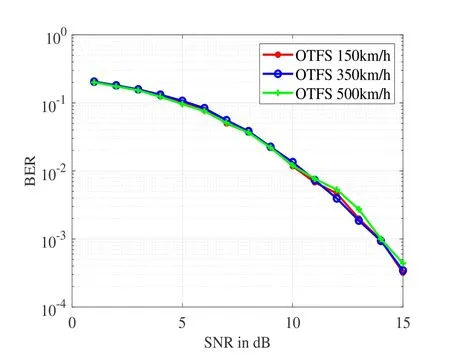
Figure 3.BER performance of OTFS with different Doppler shifts.
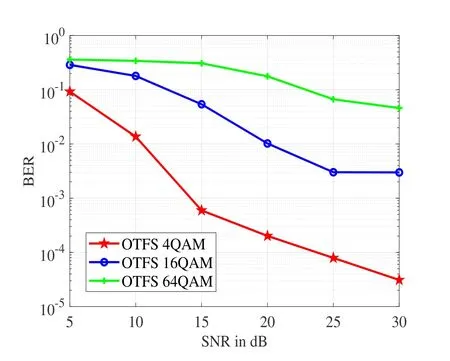
Figure 4. BER performance of OTFS with different modulation orders.
3.2 Peak Windowing Block
The peak windowing block can be written as multiplication of OTFS signals with a scale function[26,27].It can be expressed as

whereS(n) denotes scale function that can be used for reducing the signal peak levels.Besides,the scale function is such a function which is a convolution between weighting coefficientc(n)and window functionw(n),thus it can be expressed as

In addition,the clipping ratio(CR)is defined as the ratio of the clipping level(CL)to the root mean square value of the OTFS signal,denoted by

It is essential to select the weighting coefficient reasonably so that the envelope at the peak point will not exceed the CL.Therefore,the weighting coefficient could be expressed as

There are many window functions available in peak windowing block as long as they have good spectral properties [28].Kaiser,Hamming and Hanning windows are the most widely used window functions.Among these window functions,Kaiser window can easily shape spectrum by changing window length and shape parameter.The Kaiser window function with window lengthM+1 and shape parameterβcan be expressed as

whereαis defined asα=M/2,I0(·) denotes the zeroth-order modified Bessel function of the first kind andMrepresents a positive even number.Then,the Hamming window function with window lengthM+1 is defined as

In addition,the Hanning window function with window lengthM+1 is defined as

Peak windowing technique limits high OTFS signal peak level by multiplying them with a windowing function.Such limit method is a smoother way compared with hard cliping.In addition,it does not require multiple iterations to reduce the PAPR of OTFS.Therefore,peak windowing technique show its potential in IoT-R.
IV.SIMULATION RESULTS AND ANALYSIS
In this section,the BER performance of OTFS under different Doppler shifts and modulation orders is simulated firstly .Then the PAPR performance of OTFS is presented.At last,the impacts of peak windowing technique on PAPR and BER of OTFS are shown.
4.1 BER Performance of OTFS
The simulation parameters are listed in Table 1.In addition,Extended Vehicular A(EVA)model is applied for the channel delay model[29],and the Doppler shift of thei-th path is generated using
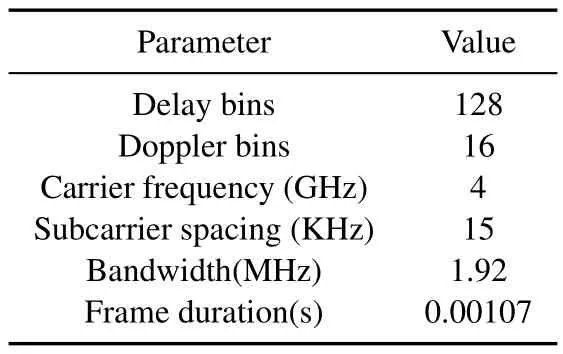
Table 1. Simulation parameters.

whereθi~ U(0,π) is uniformly distributed anddenotes maximum Doppler shift.The terminal has a velocity ofvandcis the velocity of light.The typical HSR moving speeds are 150,350 and 500 km/h.The maximum Doppler shifts caused by the train’s motion of 150,350,and 500 km/h are about 556,1296,and 1852 Hz,respectively.
Figure 3 shows the BER performance of OTFS using 4-QAM modulation order over the DD channels of different Doppler shifts.The receiver uses the lowcomplexity message passing(MP)detector[25,30].It is obvious that the BER performance of OTFS at different speeds(i.e.different Doppler shifts)is roughly the same,showing its excellent performance against Doppler shifts in high mobility scenarios.This is due to that full time and frequency diversity gain can be obtained by OTFS modulation.
In the case of 350 km/h,the BER performance of OTFS under different modulation order conditions is shown in Figure 4.The BER increases significantly as the modulation order increases.The data transmission rate of the IoT-R is relatively low,so choosing a lower modulation order such as 4-QAM can meet the requirements,and it also has fairly good BER performance.
4.2 PAPR Performance of OTFS
The CCDFs of PAPR in OTFS with different Doppler binsNare shown in Figure 5.The theoretical CCDFs of PAPR in(11)and the simulated CCDFs are plotted.The 4-QAM modulation order and Nyquist sampling are used in this simulation.It is obvious that the OTFS with smallerNhave lower PAPR and PAPR of OTFS increases asNincreases.Therefore,it is evident that the maximum PAPR in OTFS modulation grows withN,as shown in(7).In addition,the simulated CCDFs gradually matches with the theoretical CCDFs in(11)asNincreases.This shows that the theoretical CCDFs of PAPR in OTFS are more accurate for largerN.
The CCDFs of PAPR in OTFS and OFDM with differentMandNare compared in Figure 6.The 16-QAM modulation and Nyquist sampling are used.In order to compareM-subcarrier OFDM with OTFS,theMNsymbols in a frame are considered.Thus considering the CCDF of concatenation ofNOFDM symbols.The simulation result shows that OTFS can have better PAPR performance compared to that of OFDM whenNis less thanM.For example,OTFS withN=4 andM=256 has a PAPR which is approximately 2 dB lower than that of OFDM at a probability of 10-2.However,asNincreases,the CCDF of OTFS closer to that of OFDM.For example,OTFS withN=32 andM=256 only have a PAPR which is approximately 0.3 dB lower than that of OFDM at a probability of 10-2.The gain of PAPR in OTFS withN=256 andM=256 compared to that of OFDM reduces to almost zero at a probability of 10-2.This also shows that the PAPR of OTFS modulation increases withN.WhenNis small,the PAPR of OTFS modulation is better than that of OFDM.It is noted that PAPR performance of OTFS is inferior to that of OFDM whenNis larger thanM.This is because that PAPR of OFDM increases withM,unlike PAPR of OTFS which is related toN.In order to maintain a low PAPR of OTFS whenNis large,peak windowing technique is used to further reduce PAPR of OTFS.
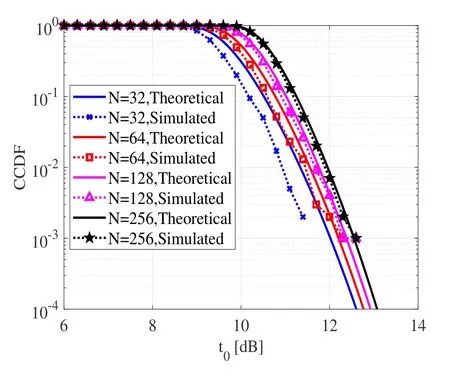
Figure 5. Theoretical and simulated CCDFs of PAPR in OTFS.
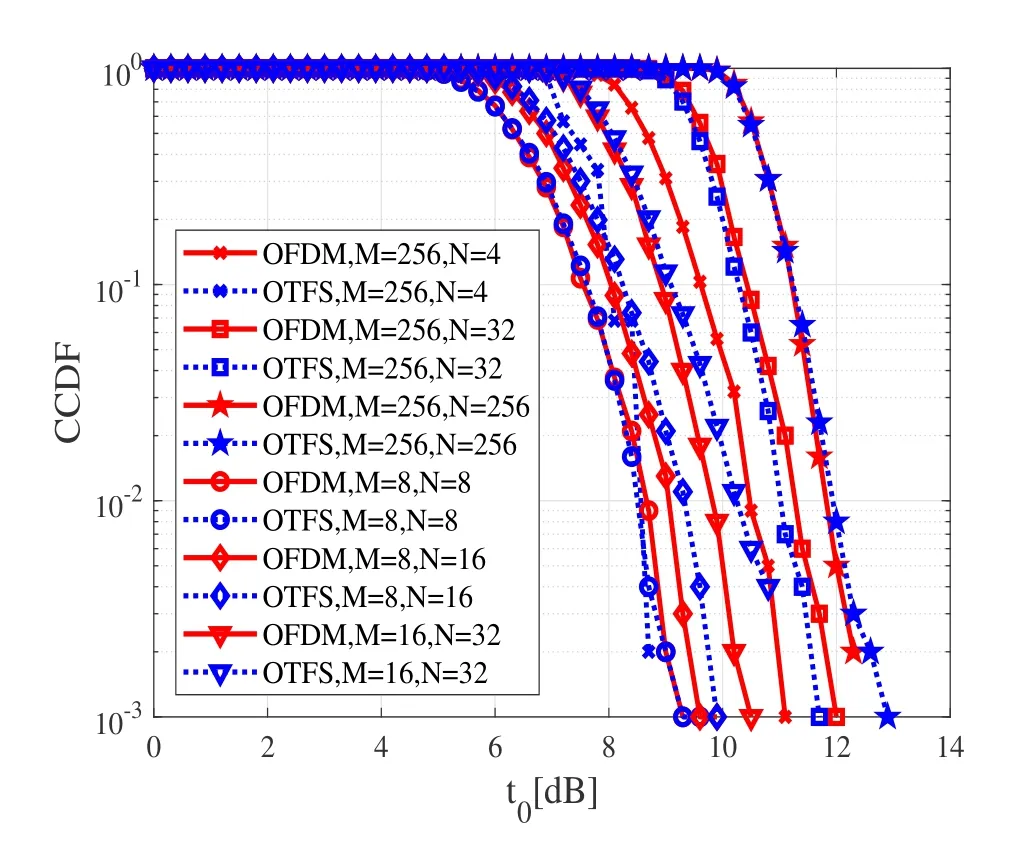
Figure 6. Comparison of CCDFs of PAPR in OTFS and OFDM.

Figure 7. The envelope of original OTFS signal and the signal using peak windowing technique.
4.3 Results Using Peak Windowing
The OTFS signal using peak windowing technique is shown in Figure 7.Peak windowing technique attenuates OTFS signal peak levels in such a way that the signal peaks multiply by the valley of a window function and the lower signals around peaks multiply by the higher amplitudes of the window function.From Figure 7,it is clear that as long as a appropriate threshold is selected,the PAPR of OTFS will significantly reduce,and the signal does not suffer major damage.The effects of different window functions on the CCDFs of PAPR in OTFS are shown in Figure 8.The PAPR of original OTFS signal and PAPR of OTFS using iterative clipping and filtering technique are considered as benchmark.The following parameters in this simulation are used:M=128,N=16,window length=3,CR=4.The number of Monte Carlo trials in the simulated CCDF carve is 1000.It is evident that three window functions(i.e.Hamming,Hanning,and Kaiser window)have roughly the same effects on PAPR reduction of OTFS.In addition,peak windowing technique can significantly reduce the PAPR of OTFS.For example,when the probability is 10-2,the PAPR of the signal using peak windowing technique is approximately 4 dB lower than that of the original OTFS signal.It is noted that iterative clipping and filtering technique can also reduce PAPR of OTFS.Due to the same clipping level,the CCDF curves of peak windowing technique and iterative clipping and filtering technique coincide with each other.
In Figure 9,the effects of different window functions on the BER of OTFS are presented.The BER of original OTFS signal and BER of OTFS using iterative clipping and filtering technique are considered as benchmark.The parameters are used as follows:M=128,N=16,window length=3,CR=4.The EVA model and MP detector are applied in this simulation.In MP detector,the maximum iteration of MP is 200 and the value of damping factor is set to 0.6.From Figure 9,the effects of Hamming and Hanning window on the BER of OTFS are almost the same and the BER of the signal using Kaiser window is slightly higher than that of the signal using Hamming and Hanning window.Furthermore,the BER of the signal using the three window functions is only a small amount of elevation compared with that of the original OTFS signal.When CR is properly selected,the BER of the signal using the three window functions will be further reduced as shown below.As can be seen from the figure,iterative clipping and filtering technique results in a significant increase in the BER of the signal.This is because iterative clipping and filtering technique is a hard clipping technique which causes great damage to the signal.
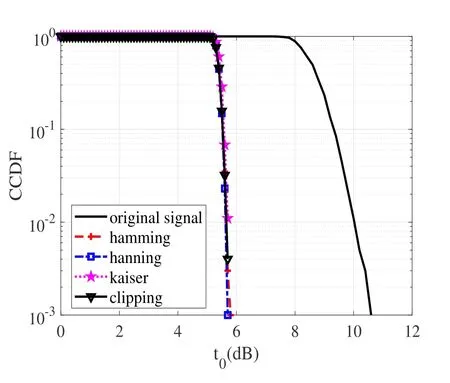
Figure 8. Effects of different window functions on the CCDFs of PAPR in OTFS.
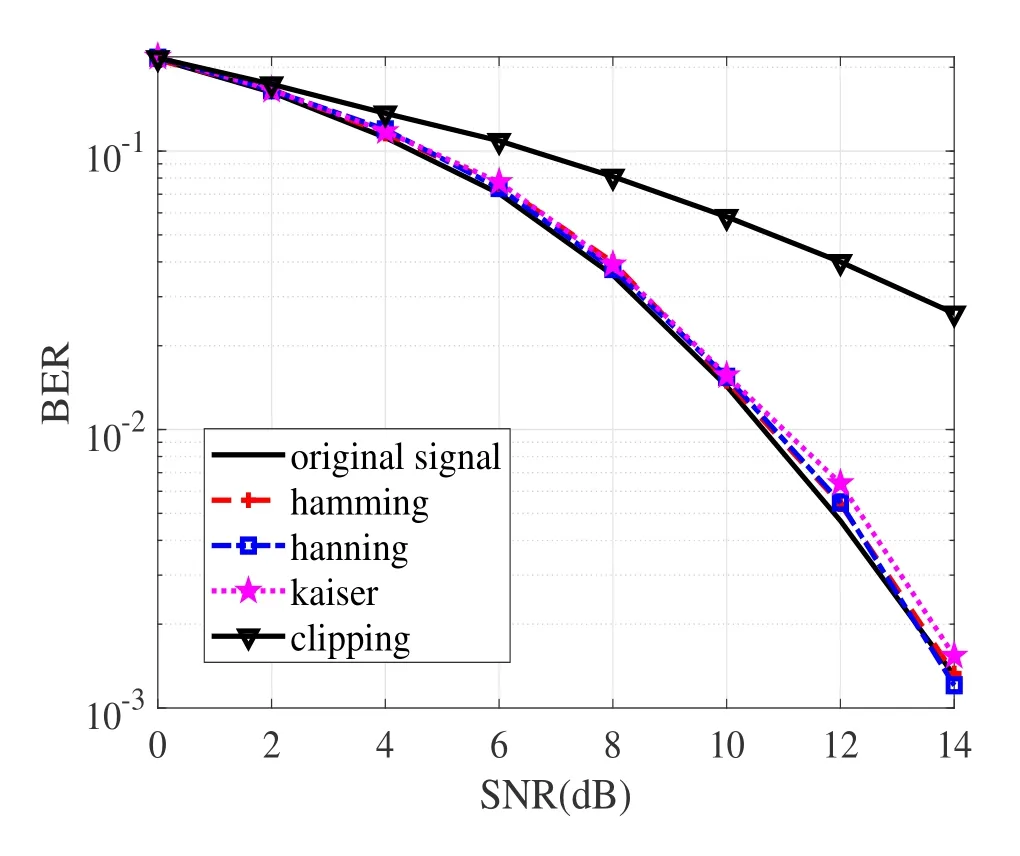
Figure 9. Effects of different window functions on BER of OTFS.
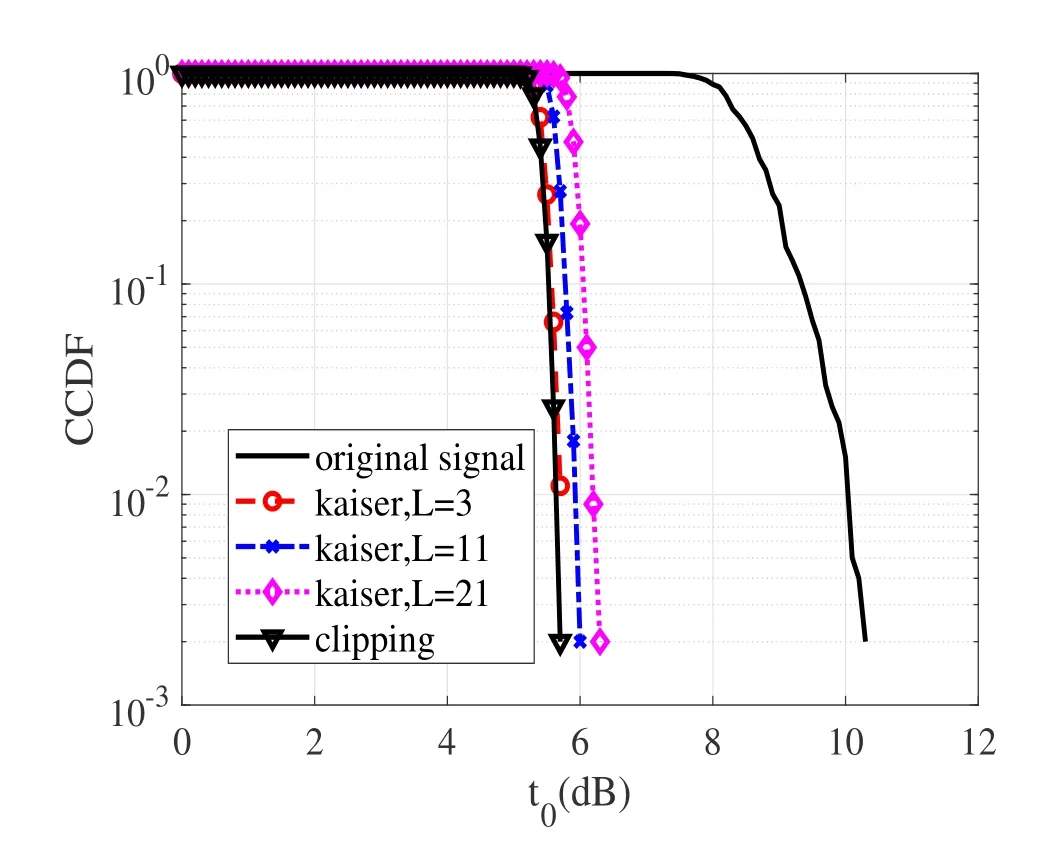
Figure 10. Effects of different lengths of Kaiser window on CCDFs of PAPR in OTFS.
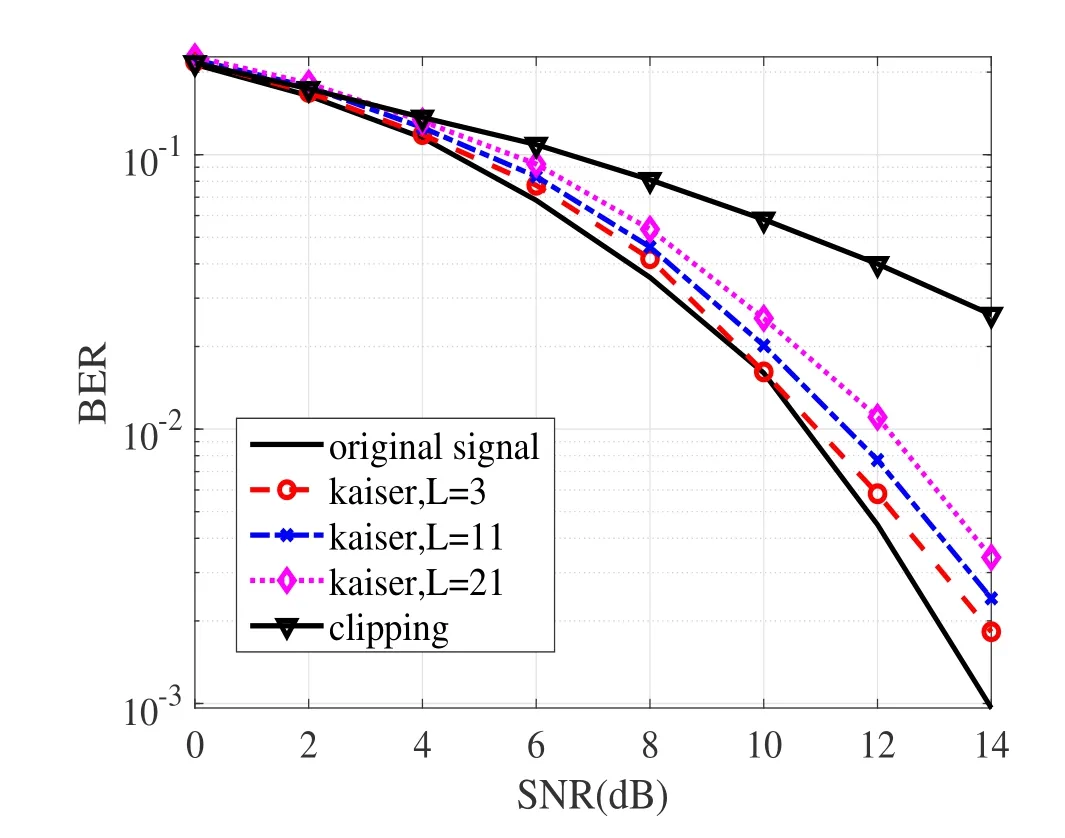
Figure 11. Effects of different lengths of Kaiser window on BER of OTFS.
The effects of different lengths of Kaiser window on the CCDFs of PAPR in OTFS are shown in Figure 10.The parameters areM=128,N=16,and CR=4.The number of Monte Carlo trials in the simulated CCDF carve is 1000.The simulation results show that as the window lengths become longer,the effects of PAPR reduction become worse.This is because as the window length increases,more signals are affected,thus reducing the average power of the signal,and then the effect of reducing PAPR becomes worse.However,as we can see from Figure 10,even though the length of Kaiser window is 21,the effect of reducing PAPR is still significant.At this time,compared with the original signal,the PAPR of the signal using peak windowing technique is about 3.8 dB lower when the probability is 10-2.In addition,it can be noted that when the Kaiser window length is 3,the peak windowing technique and the iterative clipping and filtering technique have the same effects on PAPR reduction of OTFS.
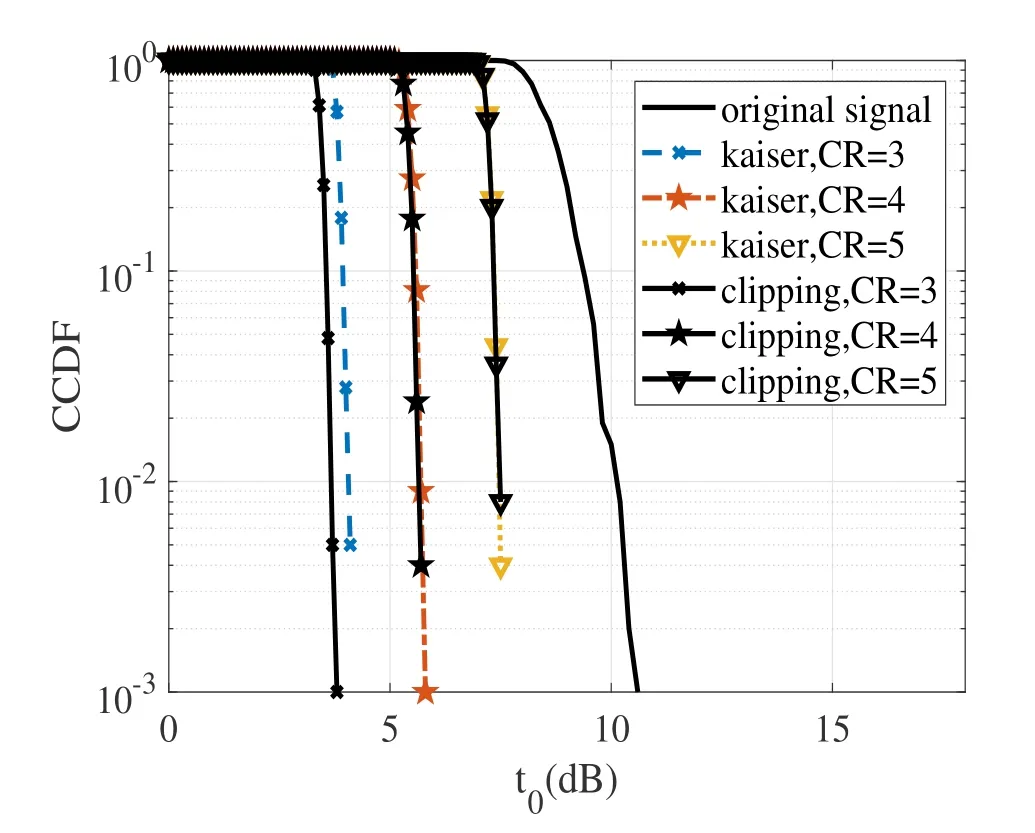
Figure 12. Effects of different CRs on CCDFs of PAPR in OTFS.
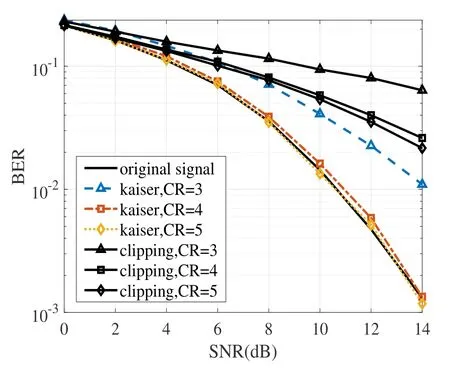
Figure 13. Effects of different CRs on BER of OTFS.
In Figure 11,the effects of different lengths of Kaiser window on the BER of OTFS are presented.The parameters are alsoM=128,N=16,and CR=4.The EVA model and MP detector are applied in this simulation.In MP detector,the maximum iteration of MP is 200 and the value of damping factor is set to 0.6.As the length of Kaiser window increases,the BER of OTFS increases.This is because as the length of the window increases,more signals are affected by the window,which makes the signal more damaged than the original signal,thereby increasing the BER of the signal.Due to the hard clipping of iterative clipping and filtering technique,BER of OTFS using iterative clipping and filtering technique has large BER loss compared with BER of OTFS using peak windowing technique.
The CCDFs of PAPR in OTFS with different CRs are shown in Figure 12.The following parameters in this simulation are used:M=128,N=16,window length=3.The number of Monte Carlo trials in the simulated CCDF carve is 1000.As aforementioned,the relationship between CR and CL is CR=CL/σ.Thus different CRs correspond to different CLs.From Figure 12,as the CR increases,the decrease of PAPR is smaller.For example,when the probability is 10-2,the PAPR is reduced by approximately 6 dB,4.2 dB,and 2.5 dB when CR=3,4,and 5,respectively.This is because increasing CR means increasing CL,so the amplitude of the peak reduction of the OTFS signal is reduced.In addition,iterative clipping and filtering technique and peak windowing technique have similar effects on reducing PAPR of OTFS.
In Figure 13,the BER of OTFS with different CRs are presented.The parameters areM=128,N=16,and window length=3.The EVA model and MP detector are applied in this simulation.In MP detector,the maximum iteration of MP is 200 and the value of damping factor is set to 0.6.It is clear that as the CR decreases,the BER of OTFS increases.The BER of the signal increases since the smaller CR makes the signal more distorted.As shown in Figure 13,when CR=3,the BER of the signal using peak windowing is significantly higher than that of the original signal.When the value of CR is 5,the BER of the signal using peak windowing is totally the same as that of the original signal.And the BER of the signal using peak windowing is slightly higher than that of the original signal when CR=4.However,due to the hard clipping,iterative clipping and filtering technique will significantly increase BER of OTFS.It proves that as long as a appropriate CR is selected,the BER of the OTFS signal using peak windowing will not change much compared to the BER of the original OTFS signal and the PAPR of OTFS can significantly decrease.This also shows the feasibility of applying the peak windowing technique in IoT-R.
V.CONCLUSION
In this paper,the suitability of OTFS modulation for application of IoT-R is investigated and discussed.The results show that OTFS modulation has good performance against Doppler shift in high mobility scenarios and OTFS modulation can have lower PAPR than OFDM,thus reducing the energy of transmitting each bit of information and extending the service life of terminal batteries in IoT-R.In addition,in order to further reduce PAPR of OTFS signal and promote the application in IoT-R,the peak windowing technique is considered to reduce the PAPR of OTFS.The impacts of different window functions,window sizes and clipping levels on PAPR and BER of OTFS are simulated and analyzed.The simulation results show that the peak windowing technique can well reduce PAPR of OTFS with fairly reasonable BER loss.The results validate potential of OTFS using peak windowing technique in IoT-R.
ACKNOWLEDGEMENT
This work is supported by the National Key R&D Program of China under Grant 2022YFF0608103,the National Natural Science Foundation of China under Grant 62001519 and 62271037.
杂志排行
China Communications的其它文章
- Secrecy Transmission of NOMA-OTFS Based Multicast-Unicast Streaming
- Orthogonal Time Frequency Space Modulation in 6G Era
- Joint Multi-Domain Channel Estimation Based on Sparse Bayesian Learning for OTFS System
- BER Performance Analysis of OTFS Systems with Power Allocation
- OTFS-Based Efficient Handover Authentication Scheme with Privacy-Preserving for High Mobility Scenarios
- Channel Estimation for OTFS System over Doubly Spread Sparse Acoustic Channels
